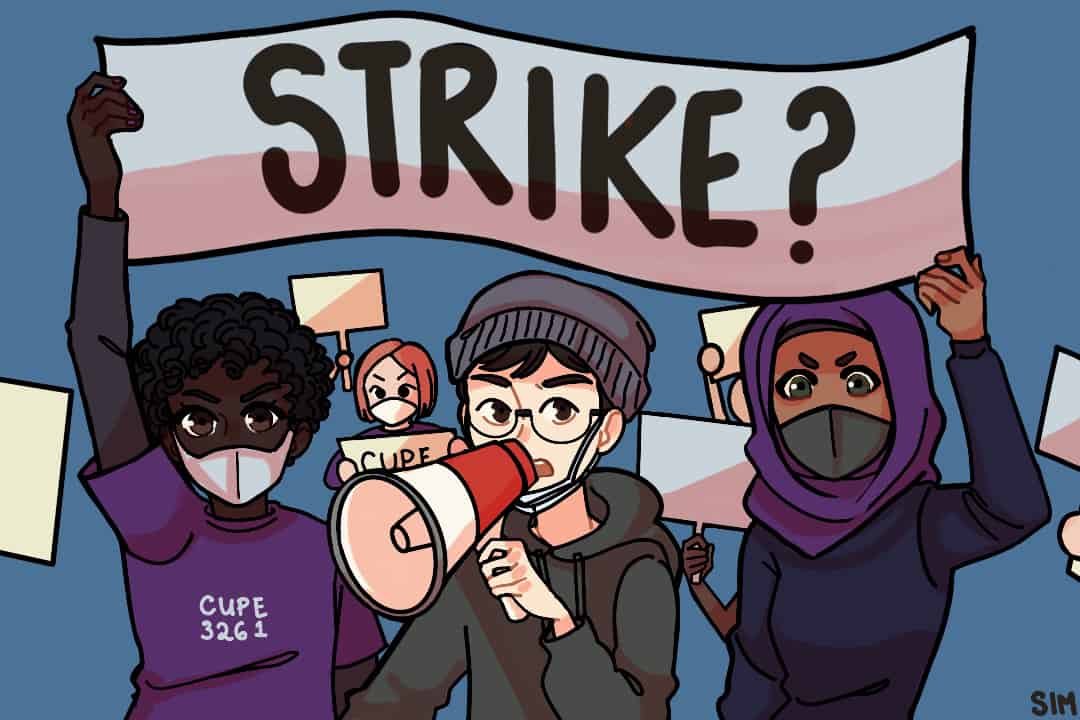We are living through an upsurge in the strength and intensity of labour organizations around the world. Canada is no exception to this, and with wages lagging behind soaring inflation, workers have been fighting for better compensation. One way they do this is through strikes.
A strike, also referred to as industrial action, is when workers collectively decide to withhold their labour by stopping or limiting their work. It can be as small as a local business or as big as India’s nation-wide strike of 250 million in 2020 — the largest strike in history.
How strikes work
Strikes are usually organized by labour unions — organizations formed by and for workers to promote their workplace interests. Strikes can be an integral part of bargaining or a way to show solidarity with other workers. They are also a means for political protests, such as the strikes in Iran against the Khomeini regime that took place this fall or the strikes by education workers in Ontario this past week. The purpose of a strike is always to stop or limit output and production to make a point — usually to promote workers’ bargaining demands.
Canadian laws state that a strike is only legal when organized by a union that has previously acquired permission from their members to strike, after a contract with the employer has expired and a new agreement is not reached, and all negotiation options for a new contract have been exhausted. At this point, the union must pass a majority vote in which the union membership decides to go on strike.
These negotiation options include conciliation, in which the Minister of Labour appoints an officer to help reach an agreement. If this fails, there is a 21-day long ‘cooling-off’ period before strikes can begin, and unions must serve at least three-day notice before a strike.
Traditionally, strikers will create picket lines, which are boundaries usually established in front of their workplace. Crossing a picket line — usually done by consumers demanding the service or other workers hired by the employer to replace strikers — is considered disrespectful and unsupportive of the strike effort.
To ensure a successful strike, unions prepare ahead of time. This can include organizing strike committees and informing union members, scouting for picket line locations, training picket captains, and making signs. Since workers are not working, they will lose income while on strike. A strike fund must also be prepared by the union to compensate the workers.
Are U of T Workers Striking?
Canadian Union of Public Employees (CUPE), Local 3261, which represents 700 service workers at the University of Toronto, reached a tentative agreement last Thursday, just over 72 hours before their strike deadline of November 21. The agreement came the day after the union held a “Day of Action for Good Jobs” in front of Sidney Smith Hall on the St. George campus with students, workers, and CUPE3902 members in attendance, to promote their campaign “Good Jobs U of T” against the contracting out of service workers’ jobs.
The tentative agreement will need to be ratified by a union vote in order to be finalized. CUPE3261 has received an outpour of solidarity and financial support from other unions, including a $25,000 donation from CUPE3902 — which represents post-doctoral researchers, sessional lecturers, and teaching assistants at U of T — toward their strike fund.
The University of Toronto’s Faculty Association released a statement in support of CUPE3261 and 3902, and donated $1,000 to the 3261 strike fund. CUPE3261 wrote an open letter to the University of Toronto, which more than 170 faculty members and librarians have signed so far in support of the union’s demand.
CUPE3902 Unit 3, which represents over 1000 academic workers at U of T, has filed a “no-board” report. Once approved by the Minister of Labour, this report starts a 17-day countdown to a potential legal strike. The union has achieved an 85 per cent vote for a strike mandate as of November 4. They are also in dispute with the university over proposed cuts to their healthcare benefits for Units 1 and 7, which could spur further work stoppage.
Other Strikes Across Ontario
You might have seen headlines about the two-day province-wide strike on November 4 and November 7 by CUPE education workers and their various protests and picket lines. Their 55,000-strong strike brought down the Ford government’s unconstitutional ‘back-to-work’ legislation. After negotiations broke down again, they served another five-day notice, meaning a strike could start on November 21.
A general strike — in which other unions join to show solidarity — was rumoured before parties reconvened negotiation last week, and it still seems to be a possibility. This general strike will likely involve public education workers across Ontario.
Public education workers are not the only ones striking in Ontario. More than 2,200 GO employees also went on strike recently, resulting in cancellation of some GO bus services. The outcome of this strike is a new tentative contract, which the union is now voting on.
Employees in higher education are also not hesitant to strike. Wilfrid Laurier University’s Contract Teaching Faculty teaching faculty is positioned to strike on November 21. However, a tentative agreement has been reached, and will likely avert a strike if union members accept it. A similar course of events occurred between faculty members and administration at Western University. Meanwhile, bargaining talks with teaching and research assistants at McMaster University have failed, and their union is gearing up to strike on November 21.


